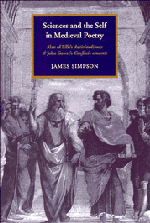 Sciences and the Self in Medieval Poetry
Sciences and the Self in Medieval Poetry Published online by Cambridge University Press: 15 December 2009
INTRODUCTION
The theoretical and practical parts of the poem are, then, each internally coherent (with the exception of Concordia and Theology's presence among the natural virtues). At the same time, each of these parts of the poem is consistent either with Alan's other writings (the noetic journey), or with works in Alan's context with which he was certainly familiar (the ethical and political endowment).
As I mentioned in the last chapter, Alan defines the levels of meaning in his poem, and the qualifications his reader will need to perceive these levels. Only, he says, the proficient student should attempt to approach the poem's ‘more subtle allegory’. The qualifications needed to understand this ‘more subtle allegory’ are defined in fairly austere terms. He says that his work contains not only the rules of human arts, but also ‘an abundance of celestial theophany’ (theophanie celestis emblema); because of this, those people who do not ‘extend the course of reason beyond the limits of sense’ should not attempt to ‘enter the narrow paths’ of the work, but only those who ‘dare to raise their mind to the intuition of supercelestial forms’ (‘rationis materiale … ad intuitum supercelestium formarum audent attollere’). This is the reader whose ‘proficient intellect’ the ‘more acute subtlety of the allegory’ will sharpen (‘acutior allegorie subtilitas proficientem acuet intellectum’).
But what allegorical meaning could this poem possibly have? An account of its plot, such as I gave at the beginning of the last chapter, gives little promise of the creative indirectness of allegory; instead, the action of the poem at its literal surface is intensely conceptual, and has the appearance more of the product of, than the occasion for, allegoresis.
To save this book to your Kindle, first ensure [email protected] is added to your Approved Personal Document E-mail List under your Personal Document Settings on the Manage Your Content and Devices page of your Amazon account. Then enter the ‘name’ part of your Kindle email address below. Find out more about saving to your Kindle.
Note you can select to save to either the @free.kindle.com or @kindle.com variations. ‘@free.kindle.com’ emails are free but can only be saved to your device when it is connected to wi-fi. ‘@kindle.com’ emails can be delivered even when you are not connected to wi-fi, but note that service fees apply.
Find out more about the Kindle Personal Document Service.
To save content items to your account, please confirm that you agree to abide by our usage policies. If this is the first time you use this feature, you will be asked to authorise Cambridge Core to connect with your account. Find out more about saving content to Dropbox.
To save content items to your account, please confirm that you agree to abide by our usage policies. If this is the first time you use this feature, you will be asked to authorise Cambridge Core to connect with your account. Find out more about saving content to Google Drive.